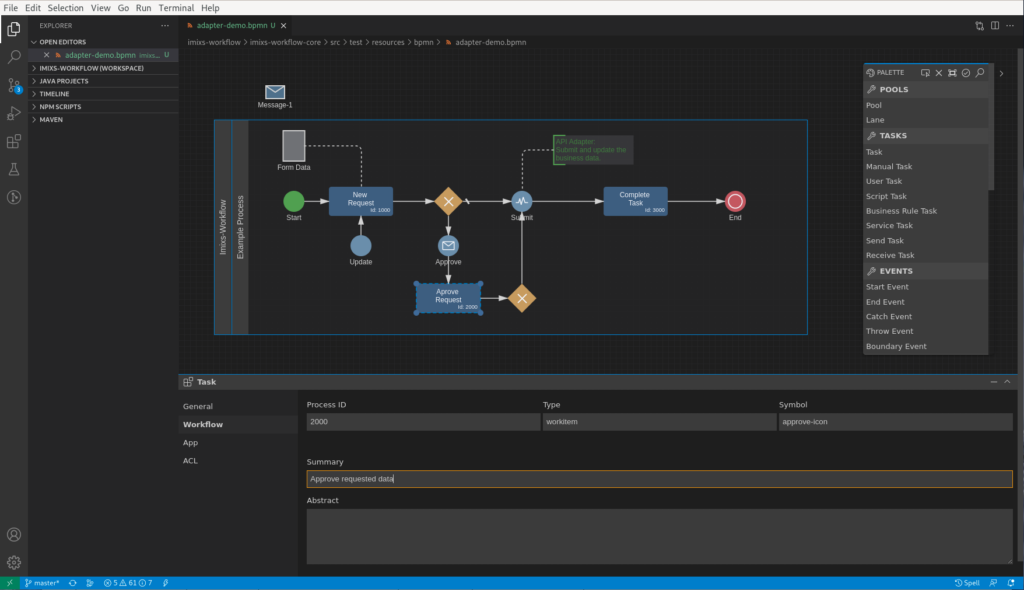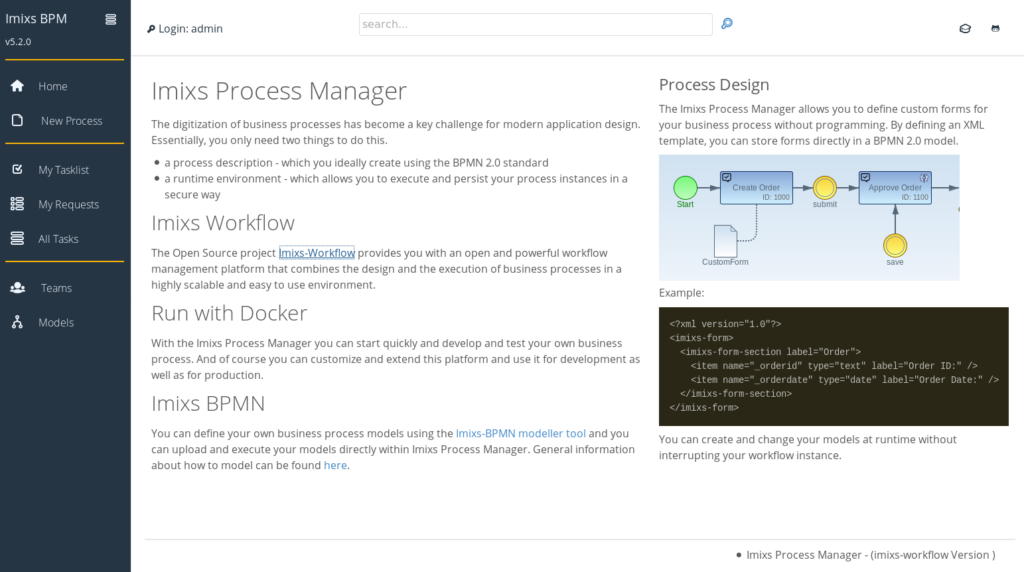A BPMN Workflow engine based on the Jakarta EE Framework forms a powerful and effective combination for developing enterprise applications with a focus on business process management. Both, Jakarta EE and BPMN 2.0 are standardized and widely supported. The scalability of Jakarta EE provides a secure foundation for building enterprise applications with robust business process management capabilities. This enables developers to leverage the strengths of both technologies to create efficient, interoperable, and maintainable BPM solutions. In the following I will explain the aspects in more detail.

Standardization:
Jakarta EE provides a standardized platform for building enterprise applications, offering a set of specifications and APIs. This standardization ensures portability and interoperability across different Jakarta EE-compliant application servers. This allows developers to work within a unified framework without the need to learn proprietary techniques. This not only streamlines the development process but also promotes a broader ecosystem where developers can focus on leveraging the standardized features, thus enhancing the overall efficiency and maintainability of the applications.
BPMN 2.0 on the other side is an industry-standard notation for modeling business processes. It provides a common language for business analysts and developers to collaborate on defining and refining business processes. This makes it easy for developers, architects and non technical teams to talk about the same things in a common language. Moreover, BPMN facilitates interoperability among various BPMN modeling tools. This compatibility ensures that models created in one tool can be seamlessly transferred and further developed in another, fostering a collaborative and flexible environment for business process modeling. BPMN effectively builds the bridge between the business and IT departments while promoting a standardized and interoperable approach to process modeling.
Integration Capabilities:
The integration of business applications into the existing IT infrastructure is essential for a sustainable architecture. Jakarta EE is designed to support the integration of various enterprise components and systems employing a robust architecture that facilitates seamless communication and collaboration. Technologies like the Java API for RESTful Web Services (JAX-RS), Java Message Service (JMS) or Jakarta Security 3.0 provide essential building blocks for developing scalable and interoperable enterprise applications. These technologies empower BPM systems to effectively handle diverse interactions with different platforms, applications, databases, and services.
Utilizing XML as its foundation, BPMN 2.0 seamlessly integrates with Jakarta EE components like the Jakarta XML Binding 4.0 API. Leveraging the BPMN 2.0 extension mechanism, a custom business process can be augmented with the technical details about integration platforms and services within a microservices architecture. This capability facilitates the orchestration of business processes spanning multiple systems and services, enabling a cohesive and efficient integration framework.
Transaction Management:
Another aspect I want to talk about are transactions. Transactions are an essential prerequisite for the execution of business processes. Jakarta EE provides a robust transaction management framework that ensures the reliability and integrity of business processes. In a BPMN Workflowsystem, multiple tasks and events can often orchestrate a single business transaction. Jakarta EE’s robust transaction management capabilities help to coordinate and synchronize these steps, ensuring that either all of them succeed or none do. This atomicity is crucial for maintaining data consistency and reliability in complex business scenarios. Jakarta EE’s transaction management support thus plays a fundamental role in the development of dependable business applications by providing a framework for handling transactions in a coordinated and fault-tolerant manner.
Scalability and Performance:
When we talk about scalability and performance, we usually only think of horizontal scaling in the form of more server capacity. But well-scalable architecture is also characterized by the optimal use of available system resources. With its micro-container architecture Jakarta EE offers features for building scalable and high-performance enterprise applications, a critical aspect for BPM systems that often need to manage a substantial volume of concurrent processes and user interactions. But Jakarta EE Application Servers also extend to modern cloud environments, allowing them to be seamlessly deployed in a cluster configuration within a cloud infrastructure. This cloud-ready nature of Jakarta EE enhances the flexibility and scalability of BPM systems, enabling them to efficiently handle varying workloads and ensuring optimal performance. The ability to run Jakarta EE Application Servers in a cluster in cloud environments underscores its relevance in supporting the development of robust and scalable BPMN-driven applications tailored to contemporary technological landscapes.
Security:
Security is an ongoing topic especially for business applications. Jakarta EE includes robust security features, addressing concerns such as authentication, authorization, and secure communication. These features are not only vital but also pivotal for building secure BPM systems, especially given the sensitive nature of the business processes and data they often handle. In the context of BPMN applications, the processing of trusted data emerges as an exceptionally crucial aspect. Jakarta EE’s security mechanisms play a paramount role in guaranteeing that only authorized users have access to specific processes and data, providing a resilient defense against unauthorized access or potential security breaches. This emphasis on processing trusted data underscores Jakarta EE’s commitment to fostering a secure environment within BPM systems, instilling confidence in the integrity and confidentiality of the information being managed.
Platforms & Tooling:
Finally let’s talk about available platforms and tools. Jakarta EE has a rich ecosystem of tools, libraries and frameworks that can be leveraged for the developing of BPMN enterprise applications. Widely used open source server platforms for building Jakarta EE applications include JBoss Wildfly, Payara/Glassfish, and Open Liberty, which are all prepared for operation in cloud environments. Applications can be seamlessly exchanged between these platforms.
For the modeling of BPMN diagrams, a variety of commercial and open-source tools are available. One free BPMN modeling tool is Open-BPMN, which can be run on different IDEs such as Visual Studio Code, Eclipse IDE, Eclipse Theia as well as a standalone web application. Open-BPMN can be utilized by business analysts to design top-level business processes, as well as by architects and developers to model the technical details of complex processing logic.

Built on the Eclipse Graphical Language Server Platform (GLSP), Open-BPMN provides an extension mechanism that allows the customization of the BPMN modelling platform to individual application requirements within a vertical domain. The use of the BPMN 2.0 extension mechanism ensures the continued validity of the BPMN 2.0 standard.
Imixs-Workflow is an Open Source BPMN Workflow engine based on the Jakarta EE Framework. In its latest version it supports Jakarta EE 10 and includes a BPMN modelling extension for Open-BPMN. Imixs-Workflow provides a comprehensive set of APIs and Plug-Ins that allows the integration of BPMN 2.0 into any business application. The workflow engine supports a powerful multi-level security concept with a fine-grained access control seamlessly integrated into the Jakarat EE Security API. With the event-driven modeling concept, human-centric workflows can be developed in less time.

Summary
In summary, the integration of a BPMN Workflow engine with the Jakarta EE Framework establishes a robust foundation for developing enterprise applications centered on business process management. The collaboration between Jakarta EE and BPMN 2.0, characterized by standardization and broad support, not only ensures the creation of efficient, interoperable, and maintainable BPM solutions but also signifies a commitment to industry standards.
